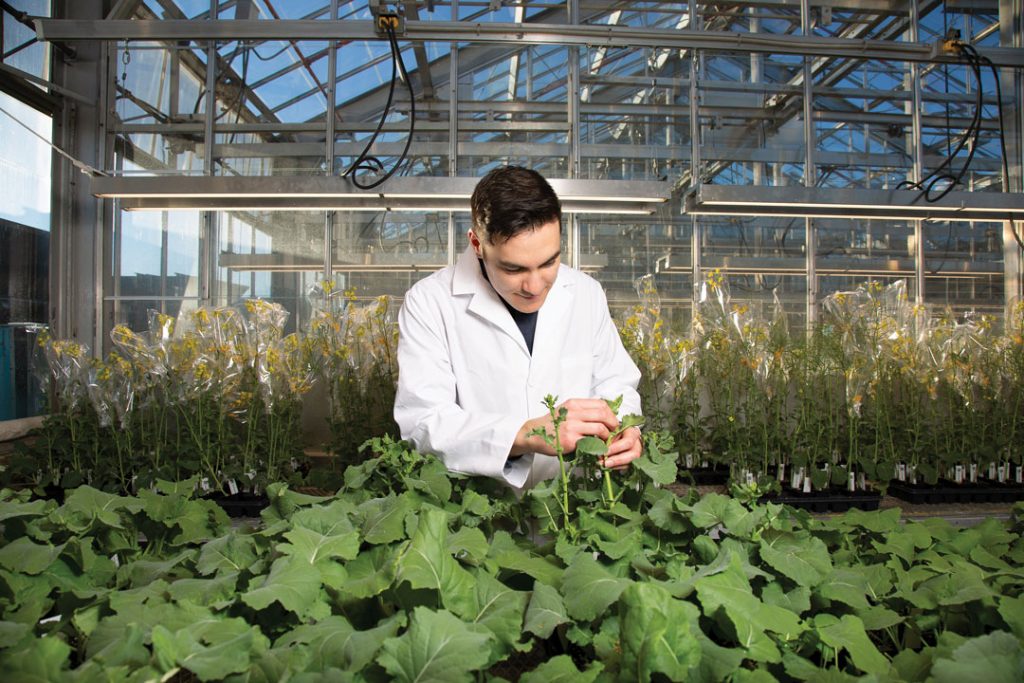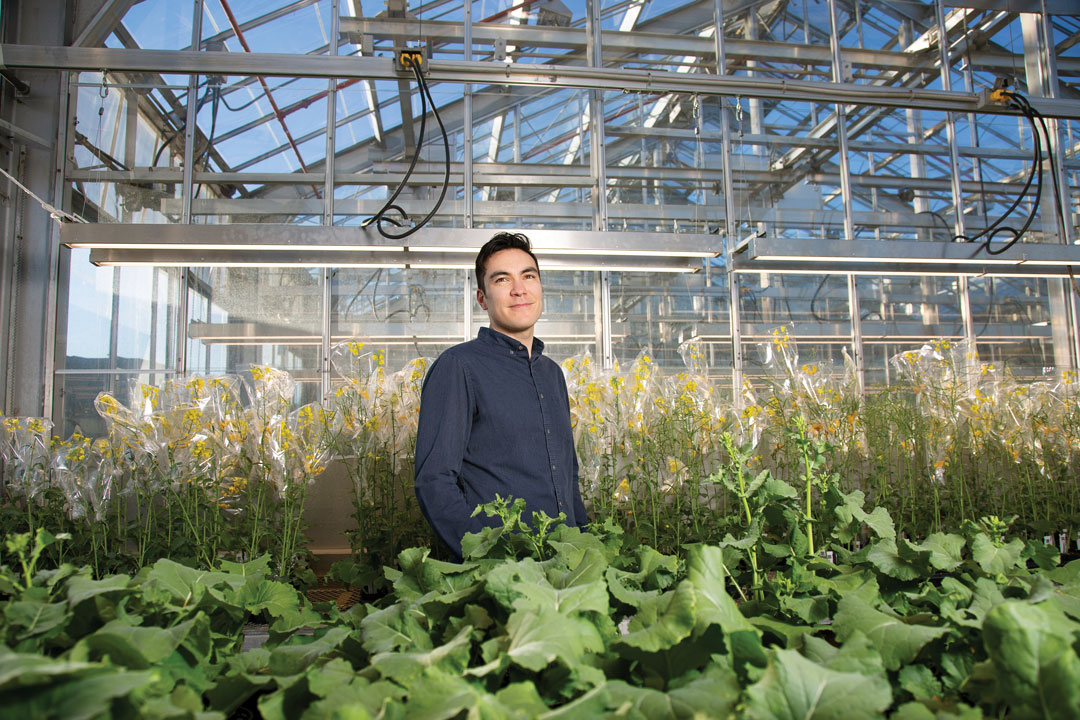THE SECRET LIFE OF BUGS
BY ELLEN COTTEE • PHOTOS BY ANTHONY HOULE PHOTOGRAPHY
From weevils to midges, beetles to spiders, professor and entomologist Boyd Mori examines the secret life of bugs. He leads a team of researchers with the University of Alberta’s Agricultural and Ecological Entomology Group. Focused on integrated pest management, the team analyzes the inner workings of insect ecosystems. This burgeoning area of study focuses on the battles between pests and beneficial insects within agriculture.
GrainsWest: Growing up, did you think you would become an entomologist?
Boyd Mori: I didn’t. I originally was going toward the medical field, but was inspired by a professor to look into entomology. Insects themselves are so diverse, and so is the study of insects.
A lot of people think of insects as pests and the only jobs involving insects as pest management or control, but there are so many fields you can work in when it comes to entomology. We have agriculture, of course, but there’s medical entomology, conservation and more.
GW: You head up the faculty of Agricultural, Life and Environmental Sciences’ Agricultural and Ecological Entomology Group. What is the aim of this group?
BM: I have a fairly big group—six grad students, three at the PhD level and three at the master’s level. I also have two post-docs and a part-time technician as part of the group. All of our work focuses on and revolves around integrated pest management through various methods, whether it’s prevention or treatment of pest issues.
One of the major projects we’re working on is trying to find out more information about the role of generalist predators like ground beetles and spiders in our agricultural system and the impact they’re having on pest species. There has been other work on generalist insects across the Prairies, and we’re digging down into that with newer, more intense technology.
GW: How is this research being done?
BM: The main approach is molecular content analysis. We can take, for example, a beetle from the field, extract the DNA in the beetle and determine what species are in its gut and, therefore, what it’s been eating in the field. We’re going to see if they’re eating pests, weeds or seeds, or if they’re just eating neutral insects like worms that have no real effect on the crop. If they’re consuming pests, we can look at how producers can make a beneficial environment to conserve or promote these insects to be a part of pest management.

GW: How is this approach different from previous research in the field?
BM: In the past, researchers have used a very targeted approach. Is this ground beetle eating wheat midge? And that’s all they’d look at. We’re going to do some of that, but on a broader scale. If we find a beetle, like a flea beetle in a canola crop, we can design specific molecular tools to pick out DNA within that beetle. In addition, however, we can use some next-generation sequencing using what’s called meta-barcoding, which will bond to any insect or arthropod DNA within the guts of that beetle. That can be matched up to a database and we can see everything the beetle is feeding on. This is a great way to see what’s really happening in the fields at a macro level.
GW: How may this research be applied in farm fields?
BM: We’re looking at different crop systems—pulses, canola, cereals—across the different agricultural ecosystems across Alberta. I think if we can identify some of these insects that are doing good things for the crop—in this case, eating pests—we can in turn better dictate agronomic activities. For example, what kind of tilling promotes these beneficial insects? What other practices will help them thrive and therefore eat pests? This is laying the foundation for future work and helping to conserve natural pest enemies, giving producers more tools to manage their crops.
GW: What additional projects is your team working on?
BM: Another of my PhD students is working on wheat midge, specifically improving the pheromone monitoring tools so producers can better monitor and respond to wheat midge issues. [They can] either respond faster or wait before putting time, money and effort into the field if they don’t have an issue yet.
I’m looking at alfalfa weevils. We have a high rate of insecticide resistance in alfalfa weevil populations in some southern Alberta alfalfa seed production fields. It was suspected at least five years ago, and then we confirmed resistance in weevil populations in southern Alberta. We’re looking at how widespread the resistance is, and then we’re looking at other options because we have relied on insecticides so much. Yes, you can rotate chemicals, but what about trying to rely on our natural pest enemies? We’re just starting down this path, but the outcomes could change how producers apply insecticides in these areas depending on their specific field.
GW: Is the direction of pest management changing?
BM: There have been a lot of re-evaluations of some of our crop protection products lately. We’re still waiting to hear about some of those, like neonicotinoids. These are used across virtually 100 per cent of our canola acres on the Prairies. If we were to lose those, what’s the next step for producers? What is the next mechanism we can try to give them? That’s weighing heavily on a lot of people’s minds and has led to these pushes and re-evaluations of management tactics.
There’s also a push from the general society, wanting to know where their food comes from and all the management tactics that go into growing their food. Whether we agree with it or not, it is a huge, huge issue that keeps coming up again and again. We need to take it into consideration when developing pest management.
GW: What pests are expected to make trouble for farmers in 2021?
BM: We had such a good growing year in 2020 and there weren’t really any insect surprises, but those good growing years, with a good mix of dry and wet weather, can bring on an increase in midge populations, specifically wheat midge. That’s definitely one to watch for in 2021.
In addition, there’s a grasshopper species in the areas north of Edmonton and into the Peace region that Scott Meers and Dan Johnson at the University of Lethbridge have been working on for a number of years that seems to have a two-year cycle where we see higher populations every second year. In 2020, their population was kind of low, so we should expect to see some more of those.
GW: Do you have any advice for farmers struggling with insect pests?
BM: Scout, scout, scout, scout. That’s number 1. Number two is to know what you’re dealing with. Being able to identify what you see is key—the types of insects, of bites on the crop and where they are located. The key thing, really, is scouting and staying on the lookout for anything that is damaging your crop.







Comments